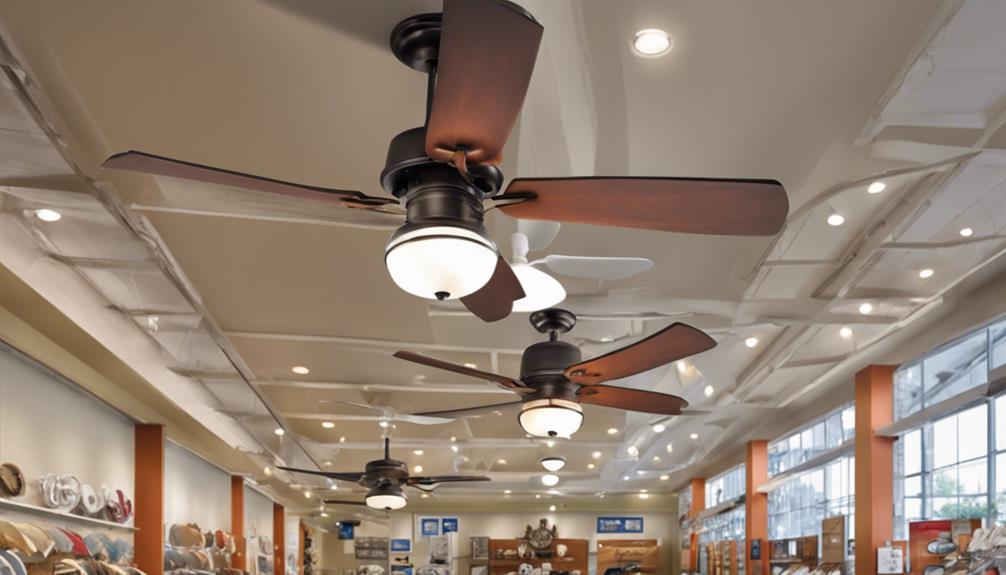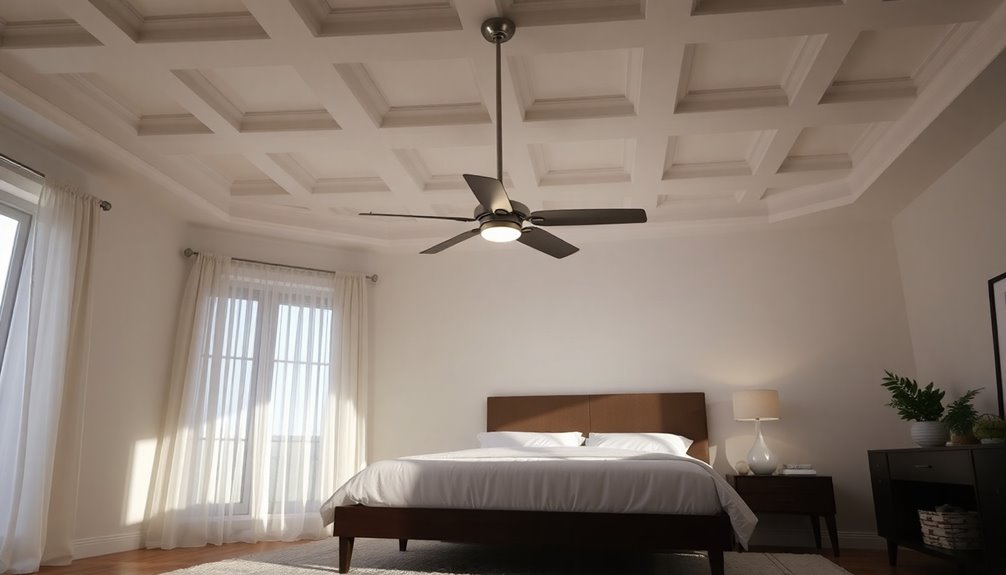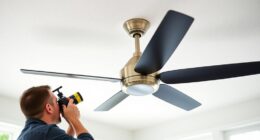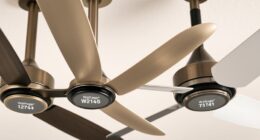Ceiling fan costs can range from $200 to $1,850, depending on various factors like installation complexity and the type of fan selected. Additional features such as remote control can add $150 to $300 to the price. Labor expenses typically fall between $150 and $350, with hiring a qualified electrician potentially adding $150 to $300 extra. It's essential to consider the overall project requirements and obtain multiple quotes to ensure the best labor cost. To learn how to save on installation expenses and choose the most suitable fan type, explore the various factors affecting ceiling fan installation costs in detail.
Key Takeaways
- Average installation cost ranges from $200 to $650.
- Additional wiring types can add $100 to $500.
- Ceiling fan with a light fixture adds $100 to $300.
- Selecting a fan with remote control increases cost by $150 to $300.
- Different types of fans have installation costs ranging from $300 to $1,850.
Average Ceiling Fan Installation Cost
On average, installing a ceiling fan can cost anywhere from $200 to $650, depending on the complexity of the installation and additional features desired. The average cost includes the standard fan itself, but additional costs may arise based on the wiring requirements. Opting for different wiring types can add $100 to $500 to the overall installation expenses.
If you choose a ceiling fan with a light fixture, expect extra wiring costs ranging from $100 to $300. For added convenience, selecting a fan with a remote control can increase the total by $150 to $300. Keep in mind that the various types of ceiling fans available, like low-profile, hanging propeller, directional, and rotational fans, come with different installation costs, which can range from $300 to $1,850.
When considering a ceiling fan installation, it's essential to factor in these additional costs to ensure a smooth and efficient process.
Ceiling Fan Installation Labor Cost

When considering the cost of installing a ceiling fan, the labor expenses typically range from $150 to $350. The actual cost can be influenced by factors such as the complexity of the installation and any desired features. Hiring a qualified electrician for the installation may cost between $150 to $300 on average, depending on the scope of work. To get the best labor cost for your ceiling fan installation, it's advisable to obtain quotes from 3-4 contractors to compare prices and services offered.
| Labor Cost Range | Average Cost |
|---|---|
| $150 – $300 | $225 |
This table provides a general idea of the labor costs associated with ceiling fan installation. Remember, the final cost can vary based on the specific requirements of your installation project. By seeking multiple quotes, you can make a more informed decision regarding the labor expense for installing your ceiling fan.
Ceiling Fan Installation Cost Breakdown
To comprehensively understand the breakdown of ceiling fan installation costs, let's delve into the specific expenses involved in this process.
When installing a ceiling fan, you need to consider various costs. The ceiling fan units themselves can range from $50 to $1,400, depending on the style and features you choose. Additionally, switches for ceiling fans typically cost between $100 and $200, providing control over the fan's functions.
Labor costs for ceiling fan installation can vary from $50 to $200, depending on the complexity of the job and the time required. Wiring is another crucial aspect, with installation costs ranging from $350 to $2,000 based on the intricacy of the wiring needed.
For added convenience, a remote control kit can be purchased for $15 to $30, allowing you to adjust the fan settings from a distance. Considering these factors collectively will give you a clearer picture of the overall ceiling fan installation cost.
Ceiling Fan Cost by Type

Ceiling fans come in various types, each with its unique features and price range. From damp-rated fans for humid areas to directional fans offering targeted airflow, there's a variety to suit different needs.
Dual-motor fans for distinctive design or energy-efficient models for cost savings, the type you choose can impact both functionality and budget.
Types of Fans
Exploring the cost range of various types of ceiling fans reveals a wide array of options to suit different needs and preferences. When considering a ceiling fan purchase, you'll encounter diverse choices like:
- Directional Ceiling Fan: Prices vary from $150 to $800, providing adjustable airflow for personalized comfort.
- Dual-Motor or Rotational Ceiling Fan: Ranging from $200 to $1,500, these offer unique design and enhanced functionality.
- Energy Star Certified Ceiling Fan: Priced between $60 to $600, these fans prioritize energy-efficient cooling solutions.
- Hanging Propeller Ceiling Fan: With prices ranging from $150 to $550, these fans are perfect for larger rooms with a touch of unique design.
Price Range
When considering the price range of ceiling fans by type, one can expect to find a variety of options to fit different budgets and preferences. Here is an overview of the average costs of different types of ceiling fans:
| Type | Price Range |
|---|---|
| Standard Ceiling Fan | $200 – $650 |
| Low-Profile Fan | $200 – $650 |
| Hanging Propeller Fan | $300 – $900 |
| Directional Fan | $300 – $1,200 |
| Rotational Fan | $350 – $1,850 |
These figures give a rough estimate of the cost range for each type of ceiling fan, excluding the cost of installing. Whether you prefer a standard, low-profile, hanging propeller, directional, or rotational fan, there are options available to suit various budgets.
Factors Affecting Ceiling Fan Installation Cost

When it comes to the cost of installing a ceiling fan, factors like the complexity of the installation and the materials used can greatly impact the final price. Labor costs, based on the features and intricacies of the installation, can also play a significant role in determining the overall expense.
Considering these factors beforehand can help in planning and budgeting for a ceiling fan installation project.
Installation Complexity Factors
Installing a ceiling fan can be significantly impacted by factors related to its complexity, such as new wiring requirements and the type of fan being installed. Factors affecting the installation cost include:
- The type of ceiling fan (standard, low-profile, hanging, directional, rotational)
- Additional features like built-in lighting and remote control capabilities
- Compatibility with existing wiring, switches, and ceiling heights
- The need for professional installation, permits, and specialized tools
Considering these factors is crucial in determining the overall cost of installing a ceiling fan. To ensure a seamless installation process, it's essential to assess the complexity involved and make informed decisions based on the specific requirements of your space.
Material and Labor Costs
Material and labor costs play a significant role in determining the overall expense of installing a ceiling fan. The type of fan chosen greatly influences the installation cost, with standard fans ranging from $50 to $300.
Additional features like new wiring, switches, or specialty units such as directional or rotational fans can further impact labor costs, with prices varying based on complexity. Specialty units may cost between $150 to $1,500 for installation alone.
When considering the total cost of ceiling fan installation, it's essential to account for not just the unit cost but also the labor fees and any extra features desired, such as remote control kits or specialized mounting options.
Additional Costs for Ceiling Fan Installation

Considering a ceiling fan installation, one must be prepared for additional costs that may arise beyond the initial purchase price. These can include:
- Wiring Upgrades: Costs range from $100 to $500 for basic wiring and up to $2,000 for new wiring, ensuring safety and efficiency.
- Light Fixture: Installing a ceiling fan with a light fixture may incur extra costs of $100 to $300 for additional wiring, providing both illumination and comfort.
- Switches: Adding switches for a ceiling fan can range from $100 to $200, offering control and convenience tailored to your needs.
- Remote Control: Opting for a ceiling fan with a remote control can lead to additional costs of $150 to $300, enhancing accessibility and ease of use.
These additional expenses contribute to a seamless and personalized ceiling fan installation experience, ensuring that your investment meets your specific needs and preferences.
Benefits of Installing a Ceiling Fan

Enhancing room comfort and energy efficiency, a ceiling fan offers multiple benefits when properly installed. By increasing airflow and ventilation, a ceiling fan can significantly improve the overall comfort of a room. Not only does it help in circulating air effectively, but it also contributes to reducing energy costs as a more energy-efficient cooling option.
The proper installation of a ceiling fan enhances air circulation, making the room feel more comfortable while adding to the aesthetics of the space as a cost-effective home improvement solution. Additionally, using a ceiling fan can help reduce allergens and enhance air quality in your home.
DIY Vs. Professional Installation

When it comes to installing a ceiling fan, the choice between DIY or professional installation can have significant implications for both your safety and the effectiveness of the fan.
- DIY Ceiling Fan installation can save $150 – $350, but safety risks like incorrect wiring or fan mounting are crucial considerations.
- Hiring a Professional Ceiling Fan installer or electrician ensures proper mounting and reduces safety hazards.
- Forbes Home recommends hiring a pro for ceiling fan installation to prioritize safety and functionality.
- Professional installation guarantees optimal performance, proper wiring, and alleviates safety concerns associated with DIY projects.
Deciding on how to install a ceiling fan isn't just about cost; it's about ensuring the safety of your household and the longevity of your fan. Whether you choose to tackle it yourself or hire a professional, proper installation is key to enjoying a safe and effective cooling solution.
Ways to Save on Installation Costs

To save on installation costs for a ceiling fan, exploring options like installing multiple fans simultaneously or leveraging existing wiring can lead to significant savings. Installing several fans at once can help reduce the hourly rate charged by professionals, ultimately lowering labor costs.
Additionally, choosing a location with existing wiring can significantly decrease installation expenses. If you're looking to save money, consider hiring a handyperson for basic installations instead of opting for a professional electrician, as this could lead to more affordable services.
Obtaining quotes from at least three contractors allows you to compare prices and find the best deal for your ceiling fan installation. Furthermore, purchasing ceiling fans off-season can result in better deals and additional cost savings on installation.
Ceiling Fan Installation Timeframe

Installing a ceiling fan involves several steps that may take 1-4 hours, depending on the complexity of the wiring and additional features.
This process includes:
- Mounting the fan
- Making proper wiring connections
- Testing its functionality
For more intricate installations, like those requiring remote controls, the timeframe may extend further to ensure a safe and efficient setup.
Installation Process Overview
Ceiling fan installation typically takes about 1-2 hours for basic setups, but may require up to 3-4 hours if new wiring is needed. When considering the time frame for installation, it's essential to account for the wiring complexity and any additional customizations or accessories you may want to include.
Opting for professional installation ensures efficient and timely completion, offering peace of mind throughout the process. Hiring a pro can streamline the installation, allowing you to enjoy your new ceiling fan sooner rather than later. Trusting a professional for the task not only guarantees a job well done but also provides a sense of belonging to a community of individuals who value quality workmanship.
Time Required for Installation
The estimated time for installing a ceiling fan can vary depending on the level of complexity and any additional electrical requirements. Basic installations typically take 1-2 hours, but if new wiring is needed, it may require 3-4 hours.
Hiring a professional can make the process more efficient. Understanding the estimated timeframe helps in planning for any disruptions. It's essential to consider the complexity of the installation and the extent of electrical work required.
Outdoor Ceiling Fan Cost Considerations

Considering the various factors influencing outdoor ceiling fan costs can help in making an informed decision for your purchase. When looking at outdoor ceiling fan costs, it's essential to factor in not just the initial purchase price, but also the installation labor, moisture rating, weather-resistant features, and overall durability. Here are some key considerations to keep in mind:
- Opt for a fan with a high moisture rating to ensure longevity.
- Choose weather-resistant features for enhanced durability.
- Prioritize proper ventilation to maintain comfort in outdoor spaces.
- Consider the aesthetics of the fan to complement your outdoor decor seamlessly.
Ceiling Fan Cost Vs. Air Conditioning

When comparing the cost of operating a ceiling fan versus central air conditioning, the significant difference in energy consumption becomes evident. Ceiling fans are more cost-effective, with an average hourly cost of $0.01 – $0.05, while central air conditioning can cost $0.36 – $1.08 per hour.
Additionally, ceiling fans are more energy-efficient, using around 60 watts of electricity compared to air conditioners that consume 3500 watts. The initial cost of installing a ceiling fan is also much lower, ranging from $50 to $1,500, in contrast to central air conditioning systems, which can cost $5,000 – $7,000.
Ceiling Fan Installer Estimates

With installation costs dependent on factors like complexity and additional features, estimating the cost for a ceiling fan installer involves considering various elements such as labor, wiring needs, and the type of fan. When determining the total expense, keep in mind the following factors:
- The average cost for installing a ceiling fan ranges from $150 to $350 for labor.
- Additional costs may include $100 to $300 for extra wiring for fan lights and $100 to $200 for switches.
- Labor costs can vary based on complexity, with basic installations averaging $150 to $300.
- Installing a ceiling fan with remote control may incur an additional cost of $150 to $300.
Understanding the intricacies of these elements can help you prepare financially and make informed decisions when hiring a professional for your ceiling fan installation needs. By being aware of these cost estimates, you can feel confident in your choices and ensure a smooth and efficient installation process.
Frequently Asked Questions
How Much Should a Good Ceiling Fan Cost?
A good ceiling fan should balance cost with quality features like energy efficiency, noise level, and ease of installation. Design options, remote control, warranty coverage, blade material, motor power, and size choices are key factors to consider.
Finding a fan that fits your room size and preferences is essential. I'd recommend looking for a fan that offers a good balance of these features to ensure a comfortable and efficient cooling experience.
How Much Does a Standard Ceiling Fan Cost?
When considering a standard ceiling fan, various factors affect the cost. Energy efficiency, installation process, warranty coverage, remote control options, blade material, design aesthetics, noise levels, maintenance requirements, and additional features all play a role in determining the final price.
These considerations contribute to the overall value of the ceiling fan, making it essential to weigh each aspect carefully before making a purchase decision.
What Is the Standard Price for a Ceiling Fan?
When looking for a ceiling fan, consider factors like:
- Styles
- Energy efficiency
- Installation ease
- Remote control options
- Blade material
- Noise level
- Warranty coverage
- Smart home integration
- Customization choices
These aspects can affect pricing and overall satisfaction. Researching these features before purchase ensures you find the right fit for your needs and budget.
How Much Does It Cost to Keep a Ceiling Fan Running 24 7?
Running a ceiling fan 24/7 can vary in cost from $0.06 to $0.24 per day, based on wattage and electricity rates.
For a 70-watt fan, monthly expenses range from $4.20 to $16.80.
Opting for energy-efficient models can reduce these costs.
Combining a fan with air conditioning can also cut overall cooling expenses.
My experience shows that being mindful of wattage and electricity rates can lead to significant savings in the long run.
Can I Install a Remote Controlled Ceiling Fan Without a Wall Switch?
Yes, you can install a remote controlled ceiling fan without a wall switch. Simply wire the fan directly to a power source and use the provided remote controlled ceiling fan switch to control the fan’s speed and light settings. This allows for convenient operation without the need for a wall switch.
Conclusion
As I sit under my newly installed ceiling fan, I can't help but feel like I'm in a cool oasis on a hot summer day. The cost was worth every penny for the comfort it brings.
Don't let the price tag deter you from investing in a ceiling fan – the benefits far outweigh the cost.
So go ahead, treat yourself to a breeze of relief and enjoy the savings on your energy bill too.









